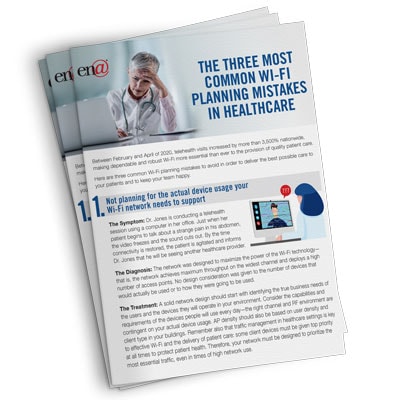Between February and April of 2020, telehealth visits increased by more than 3,500% nationwide, making dependable and robust Wi-Fi more essential than ever to the provision of quality patient care.
Here are three common Wi-Fi planning mistakes to avoid in order to deliver the best possible care to your patients and to keep your team happy.
1. Not planning for the actual device usage your Wi-Fi network needs to support
Dr. Jones is conducting a telehealth session using a computer in her office. Just when her patient begins to talk about a strange pain in his abdomen, the video freezes and the sound cuts out. By the time connectivity is restored, the patient is agitated and informs Dr. Jones that he will be seeing another healthcare provider.
The network was not designed to maximize the power of the Wi-Fi technology—instead, the network achieves maximum throughput on the widest channel while deploying a high number of access points. No design consideration was given to the number of devices that would actually be used or to how they were going to be used.
A solid network design should start with identifying the true business needs of the users and the devices they will operate in your environment. Consider the capabilities and requirements of the devices people will use every day—the right channel and RF environment are contingent on your actual device usage. AP density should also be based on user density and client type in your buildings. Remember also that traffic management in healthcare settings is key to effective Wi-Fi and the delivery of patient care: some client devices must be given top priority at all times to protect patient health. Therefore, your network must be designed to prioritize the most essential traffic, even in times of high network use.
2. Not performing a thorough network assessment before deploying new access points
Dr. Garcia is on her way to check on her patient who delivered a baby the previous day. As she heads down the hospital’s stairs, she attempts to update another patient’s EMR. Unfortunately, the coverage is spotty despite multiple APs in the stairwell and adjacent floors, and her update doesn’t go through. She doesn’t realize the message has failed until an hour later, causing a delay in the patient’s treatment.
Though it is intuitive to add access points when you want to boost the speed and capacity of your network, doing so can worsen your network’s performance in some circumstances. Multiple APs in close proximity can cause interference, resulting in unreliable and spotty Wi-Fi coverage.
While it is tempting to add more APs to maximize throughput, this problem can be best solved through quality engineering. Skilled engineers will conduct thorough site assessments and use heat mapping technology to place access points where they optimize the user experience for each of your coverage areas.
3. Assuming new hardware is a panacea for all your Wi-Fi problems
Dr. Wilson is discussing a patient’s treatment plan with other doctors during a video conference call. Even though the IT team has just invested in cutting-edge hardware, the physicians struggle to maintain a stable connection. As a result, the meeting runs long, causing scheduling delays for each physician. At the end of the month, Dr. Jones accepts a position at another healthcare facility that has a robust and reliable Wi-Fi infrastructure and renowned telehealth program–and fewer headaches.
Unfortunately, many healthcare providers invest large sums in upgrading to the latest technologies only to find their service unimproved. A network may sometimes deliver unsatisfactory service due to no fault of your equipment but due to an upstream problem, such as the speed of the connection your organization receives from your Internet provider.
It’s essential to think of a network as a holistic system and not just a series of unrelated parts. To improve your network performance, you would be well served by engaging expert engineers to run a top-to-bottom network diagnosis. Doing so will not only help your providers keep operations running smoothly, it will help you create an environment that satisfies the needs of both clinicians and patients.

